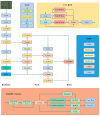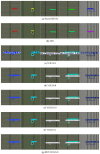RST-YOLOv8: An Improved Chip Surface Defect Detection Model Based on YOLOv8
- PMID: 40648118
- PMCID: PMC12251869
- DOI: 10.3390/s25133859
RST-YOLOv8: An Improved Chip Surface Defect Detection Model Based on YOLOv8
Abstract
Surface defect detection in chips is crucial for ensuring product quality and reliability. This paper addresses the challenge of low identification accuracy in chip surface defect detection, which arises from the similarity of defect characteristics, small sizes, and significant scale differences. We propose an enhanced chip surface defect detection algorithm based on an improved version of YOLOv8, termed RST-YOLOv8. This study introduces the C2f_RVB module, which incorporates RepViTBlock technology. This integration effectively optimizes feature representation capabilities while significantly reducing the model's parameter count. By enhancing the expressive power of deep features, we achieve a marked improvement in the identification accuracy of small defect targets. Additionally, we employ the SimAM attention mechanism, enabling the model to learn three-dimensional channel information, thereby strengthening its perception of defect characteristics. To address the issues of missed detections and false detections of small targets in chip surface defect detection, we designed a task-aligned dynamic detection head (TADDH) to facilitate interaction between the localization and classification detection heads. This design improves the accuracy of small target detection. Experimental evaluations on the PCB_DATASET indicate that our model improved the mAP@0.5 by 10.3%. Furthermore, significant progress was achieved in experiments on the chip surface defect dataset, where mAP@0.5 increased by 5.4%. Simultaneously, the model demonstrated significant advantages in terms of computational complexity, as both the number of parameters and GFLOPs were effectively controlled. This showcases the model's balance between high precision and a lightweight design. The experimental results show that the RST-YOLOv8 model has a significant advantage in detection accuracy for chip surface defects compared to other models. It not only enhances detection accuracy but also achieves an optimal balance between computational resource consumption and real-time performance, providing an ideal technical pathway for chip surface defect detection tasks.
Keywords: RST-YOLOv8; chip surface defect detection; feature representation; small object detection.
Conflict of interest statement
The authors declare no conflict of interest.
Figures


















Similar articles
-
YOLO-RDM: A high accuracy and efficient algorithm for magnetic tile surface defect detection with practical applications.PLoS One. 2025 Jul 18;20(7):e0328815. doi: 10.1371/journal.pone.0328815. eCollection 2025. PLoS One. 2025. PMID: 40680067 Free PMC article.
-
LI-YOLOv8: Lightweight small target detection algorithm for remote sensing images that combines GSConv and PConv.PLoS One. 2025 May 23;20(5):e0321026. doi: 10.1371/journal.pone.0321026. eCollection 2025. PLoS One. 2025. PMID: 40408346 Free PMC article.
-
YOLOv8-DuckPluck: A lightweight target detection model for cherry valley duck feather pecking site detection.Poult Sci. 2025 Jun 26;104(10):105484. doi: 10.1016/j.psj.2025.105484. Online ahead of print. Poult Sci. 2025. PMID: 40618564 Free PMC article.
-
Comparison of self-administered survey questionnaire responses collected using mobile apps versus other methods.Cochrane Database Syst Rev. 2015 Jul 27;2015(7):MR000042. doi: 10.1002/14651858.MR000042.pub2. Cochrane Database Syst Rev. 2015. PMID: 26212714 Free PMC article.
-
Systemic pharmacological treatments for chronic plaque psoriasis: a network meta-analysis.Cochrane Database Syst Rev. 2017 Dec 22;12(12):CD011535. doi: 10.1002/14651858.CD011535.pub2. Cochrane Database Syst Rev. 2017. Update in: Cochrane Database Syst Rev. 2020 Jan 9;1:CD011535. doi: 10.1002/14651858.CD011535.pub3. PMID: 29271481 Free PMC article. Updated.
References
-
- Wang X., Gao S., Guo J., Wang C., Xiong L., Zou Y. Deep Learning-Based Integrated Circuit Surface Defect Detection: Addressing Information Density Imbalance for Industrial Application. Int. J. Comput. Intell. Syst. 2024;17:29. doi: 10.1007/s44196-024-00423-w. - DOI
-
- Wei L., Solihin M.I., Astuti W., Hong L.W., Kit A.C. Surface Defects Detection of Cylindrical High-Precision Industrial Parts Based on Deep Learning Algorithms: A Review. Oper. Res. Forum. 2024;5:58. doi: 10.1007/s43069-024-00337-5. - DOI
-
- Redmon J. You only look once: Unified, real-time object detection; Proceedings of the IEEE Conference on Computer Vision and Pattern Recognition; Las Vegas, NV, USA. 27–30 June 2016.
-
- Redmon J., Farhadi A. YOLO9000: Better, faster, stronger; Proceedings of the IEEE Conference on Computer Vision and Pattern Recognition; Honolulu, HI, USA. 21–26 July 2017; pp. 7263–7271.
-
- Farhadi A., Redmon J. Yolov3: An incremental improvement; Proceedings of the Computer Vision and Pattern Recognition; Salt Lake City, UT, USA. 18–22 June 2018; Berlin/Heidelberg, Germany: Springer; 2018. pp. 1–6.
LinkOut - more resources
Full Text Sources

